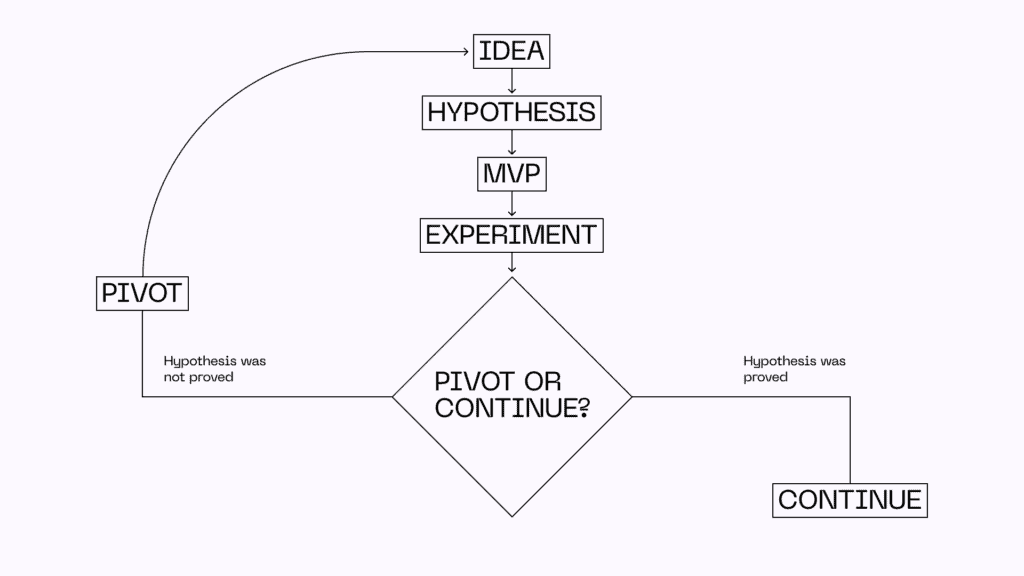A minimum viable product (MVP) isn’t just a budget-friendly way to test a business idea; it’s how global tech leaders got their start. Spotify began as a stripped-down desktop app. Airbnb tested its model by renting out space in its founders’ apartment. Even Dropbox launched with a demo video instead of software. Their MVPs weren’t perfect, but they were fast, focused, and grounded in learning.
And yet, many teams today still bypass the MVP stage, investing heavily in fully built products before validating anything. The result? 80% of startups don’t make it.
At Syndicode, we’ve spent a decade helping startups and enterprises de-risk product launches by shaping and building lean MVPs. In this guide, we’ll walk you through exactly how to plan, build, and validate a successful MVP: from choosing your implementation strategy to avoiding the most common mistakes.
You’ll also see real-world examples, tactical planning frameworks, and cost factors to consider. If you’re validating a new product concept or planning a high-stakes feature rollout, this blog post will give you a clear, step-by-step foundation.
We’ll start with the basics, but you can skip right to the steps by clicking here.
What is an MVP?
An MVP—or Minimum Viable Product—is the simplest version of your idea that’s still both usable and valuable. Its real job isn’t to impress; it’s to answer one question: Is this worth building further?
If you’re building a startup, an MVP is often indispensable. Yet, established companies use them too, especially when entering new markets, testing bold business ideas, or launching spin-offs under time pressure.
The tricky part? Most teams think of MVPs in binary terms. Either you build something too minimal and it flops, or you go all-in and hope the full version lands. But in reality, a successful MVP sits right in the middle, between “just enough” and “too much.”

An MVP isn’t the first 10% of your roadmap. It’s not a sketch or a wireframe. It’s a product. Small, yes—but complete enough to be put in front of users and deliver real value.
And when you strike that balance, something powerful happens:
You stop guessing. You get real feedback. You see how users behave, not just what they say. That’s where the momentum begins.
But here’s the rule to remember: every version of your MVP must stand on its own. Even as it evolves, each release should be usable, testable, and valuable in its own right. That’s what makes it a true MVP: not a half-built app, but a focused, functional solution with room to grow.

Benefits of MVP development
Since you’re reading this, you probably already have some expectations as to what an MVP should bring you. Let’s go over the main benefits an MVP can really deliver beyond the buzzwords. These are the reasons why smart founders, product teams, and investors still rely on MVP software development today.
Validate business hypotheses
Before you commit to months of development, an MVP helps you test the assumptions behind your product idea. Will users actually care? Will they pay? Can your solution stand out? Launching lean lets you prove or disprove your thinking quickly and with real users, not theoretical spreadsheets.
Identify and confirm the target audience
You may think you know your ideal customer. But early MVPs will reveal the truth behind your market research and show who’s truly interested and engaged. Instead of guessing demographics or personas, you’ll start to see who signs up, who converts, and who comes back. That clarity sharpens your marketing, roadmap, and product positioning.
Minimize financial risk and optimize ROI
The cost of custom software development is often substantial. An MVP limits your initial spend and keeps you focused on only the essential features that actually drive value. This lean approach maximizes return on investment by helping you avoid overbuilding and reroute resources to what’s working faster.
Attract investors
Traction beats theory. A working MVP with active users—even a small base—can be far more persuasive to investors than a polished pitch deck. It shows technical feasibility and real-world validation, which reduces perceived risk and increases your odds of securing funding.
Curious what a successful MVP looks like?
Explore Syndicode’s featured projects to see how we’ve helped businesses validate ideas, launch fast, and grow with confidence.
View case studiesRefine toward product–market fit
Product–market fit isn’t found in brainstorming sessions: it’s earned through iteration. An MVP helps you discover what resonates, what doesn’t, and how your product should evolve to truly meet customer needs. You’re not building a final product, you’re building the path to product–market fit.
Gather actionable customer feedback
The earlier you hear from users, the more agile your team can be. An MVP lets you gather valuable feedback on real usage, not opinions about mockups. That means faster course correction, better feature prioritization, and clearer insight into what customers truly value.
Enable early monetization
You don’t need a full-fledged product to start generating revenue. A well-scoped MVP can begin solving real problems from day one, giving you a chance to test pricing, build revenue streams, and prove market demand before scaling up your operations.
One example is Evrlearn, one of Syndicode’s clients. They launched with an MVP that let them start generating revenue from day one: well before the platform was fully built. Thanks to real user feedback and early income, they were able to expand functionality strategically and keep refining the marketplace based on what their audience actually needed.
Reduce development risks
Long product cycles increase the risk of building the wrong thing. An MVP development process shortens that loop by giving you a live checkpoint at the very beginning of the journey. You’ll uncover technical challenges, UX issues, or a lack of demand before those problems get too costly to reverse.

When should you build an MVP?
A minimum viable product is your best move when you need to see how the market responds to your solution without overcommitting. The right moment usually comes just after ideation and before investing serious time, budget, or engineering resources.
If you’re solving a clear problem but aren’t yet sure how users will react, launching a new business model, entering a new market, or rolling out a major feature set, an MVP helps you validate early assumptions with real users. It’s also a powerful tool when pitching to investors as it enables you to show traction, not just theory, through real-world feedback and evidence.
Real-world examples of minimum viable products
Sometimes the best way to understand MVPs is to see how successful companies started small. Here are four standout examples of MVP thinking in action.
Stripe: Testing demand with a developer-centric MVP
Stripe began with a basic HTML site built to validate demand for a developer-first payments API. It offered a clean interface with just enough functionality (card validation, secure payments, and language support) to prove that developers wanted a simple, embeddable way to accept payments online.
Its success came from solving one specific problem well, without overbuilding.
Key lesson:
If your audience is technical, simplicity and usability are powerful differentiators. An MVP should remove friction, not introduce it.
Instagram: Pivoting to one feature that worked
Instagram started as a location-based check-in app, but users weren’t interested. The team noticed that photo sharing was gaining traction, especially among designers and creatives. They cut everything else and focused exclusively on image posting with filters as a differentiator. That shift led to viral growth.
Key lesson:
An MVP isn’t always about building. Sometimes it’s about cutting. Follow user behavior, not your original product vision.
Slack: Turning an internal tool into the main product
Slack’s origin wasn’t in SaaS; its early version was a chat tool built for internal team comms during the development of a now-defunct game. Once the team realized others had the same need for better team messaging, they pivoted and launched it as a standalone product.
Key lesson:
Your MVP might be hiding inside your workflow. Pay attention to internal tools and use cases; they can reveal scalable products.

Planning an MVP: Choose your method
Before building anything, you need a planning approach that helps you prioritize, de-risk, and focus. The frameworks below are designed to do just that. Each one supports a different stage of early product thinking, so use them where they fit best.
Lean Canvas: Mapping business assumptions
The Lean Canvas condenses your business model into a single page, covering the problem, solution, key metrics, value proposition, and channels (sometimes more). It forces you to articulate the core assumptions behind your idea before you write a single line of code.
This framework helps you stay honest about what really matters: are you solving a real problem for the right people? Instead of diving straight into features, it forces clarity around what you’re trying to prove.
It also creates a shared reference point that your entire team can align on, test against, and iterate as feedback comes in.
Use it when you’re early in the ideation stage, especially when you’re deciding what to build, why it matters, and how to validate it with an MVP.
Riskiest Assumption Test (RAT): Focusing on critical risks
The RAT method asks: What’s the one assumption that, if wrong, will kill this idea? You isolate that variable and build an experiment just to test it.
For example, imagine that you’re launching a SaaS product that automates client reporting for marketing agencies. You assume agencies want automation to replace time-consuming manual reporting.
But what if they actually value control over automation?
Using RAT, you identify your riskiest assumption: “Marketing agencies prefer fully automated reports over customizable, manual ones.”
To test this, you can set up a landing page describing your automation tool and offer a demo signup option. Then you’ll track who signs up and what messaging gets clicks and follow up with interviews or surveys.
If no one signs up or early feedback points to customization being more important than automation, you’ve validated that your core assumption needs revisiting—before building the tool.
Use it when you want to save resources and get fast validation on your most critical assumptions.
Not sure which MVP method fits your business?
Syndicode’s business analysists will help you choose the right MVP strategy based on your goals, market, and product vision. We’ll guide you through every planning decision, from discovery sessions to technical scoping.
Explore business analysis servicesJob-to-be-done (JTBD): Understanding customer needs
JTBD shifts the focus from personas to customer motivation. What job are users “hiring” your product to do? This insight helps shape the MVP development around solving the most valuable problem.
Let’s say you’re building a lightweight project management tool for freelancers. Typical thinking might lead you to build to-do lists, time tracking, and file attachments.
But through JTBD interviews, you uncover the real job: “Freelancers need help to deliver work on time without looking unprofessional to clients.”
Now the MVP shifts. Instead of bloated features, you prioritize client-ready status updates, smart deadline alerts, and a polished, shareable dashboard for deliverables.
You haven’t just built a task manager, you’ve built a reputation-preserver. And that’s what users actually care about.
Use it when: You’re trying to define your basic feature set based on what customers are actually trying to achieve.
MVP Tree: Structuring features by priority
The MVP Tree is a visual tool that helps you break your product idea into the essential features, nice-to-haves, and execution paths. You start by identifying your main user goal, then branch out into possible features, delivery methods, and scope tradeoffs.
This method provides a clear visual structure for deciding what to build now, later, or not at all.
Use it when you need to clarify the scope and avoid overbuilding, especially with limited time or dev resources.
Value proposition canvas: Aligning product with customer expectations
This tool maps customer pains, gains, and jobs on one side, and your product’s features and benefits on the other. The goal is to achieve alignment between what you offer and what the customer truly values.
Use it when: You want to refine your messaging, positioning, or MVP feature list to match real user expectations.
Build–Measure–Learn: Iterative feedback loops
From The Lean Startup methodology, this cycle encourages rapid execution: build a testable version, measure user response, and learn what to change. The loop repeats with each iteration, making your MVP smarter and leaner as it evolves.
Use it when you’re actively launching, testing, and iterating on a live product.

Building an MVP: Choose your type
Fake-door MVP
A fake-door MVP promotes a feature or product that doesn’t exist yet. This could be a landing page, a sign-up button, or a “Coming Soon” feature that lets you gauge interest based on clicks or conversions.
It’s fast, inexpensive, and highly effective for measuring interest. It also works well for A/B testing messaging and positioning. The downside? You won’t gather any behavioral data since there’s no real product behind it, and if your traffic isn’t well-targeted, you risk chasing vanity metrics.
Use it when you want to validate demand before building anything functional.
Prototype
There’s some debate around whether prototypes and proof-of-concepts (PoC) should be considered MVPs. That’s why it’s important to align on terminology with your team early. At Syndicode, we define a prototype as a non-functional, interactive simulation of your product, designed for testing ideas, not delivering value.
Prototypes are built using tools like Figma, InVision, or Adobe XD. They mimic real user flows through clickable mockups, but they don’t include any backend logic or working features. Because of this, they’re fast to create and incredibly useful for refining UX, exploring design directions, and gathering early user feedback.
That said, a prototype isn’t a substitute for a real product. You can’t test retention, performance, or pricing. In addition, some investors may view it as too hypothetical. Still, if your goal is to validate usability or secure internal buy-in, a prototype is often the best first step.
Use it when you want to test flows, navigation, or visual priorities before writing code—especially for UX-heavy products or when evaluating multiple design approaches.
Read also: A PoC for an online booking system in 48 hours
Concierge MVP
A concierge MVP delivers the full product experience but is run manually. There’s no code, no backend logic, just a simple interface and a human doing all the work behind the scenes.
It’s fast to launch, extremely flexible, and great for learning from direct user interaction. The main drawback is that manual delivery might not be able to provide the level of service customers expect, and, naturally, concierge MVPs don’t scale well.
A real-life example of a concierge MVP is HLPRS, a house service platform. The team started by manually connecting clients with contractors to test demand and service viability. After confirming strong market interest, they moved forward with an automated marketplace.
Use it when you want to simulate your service fast and validate the core value with a minimum of code.
Single-feature app MVP
This is a stripped-down, working product that does just one thing really well. It delivers your core value proposition without distractions or unnecessary features.
A single-feature MVP is fast to build, simple to maintain, and often monetizable right away. Its narrow scope also makes feedback more actionable and precise. On the other hand, it’s not suitable for complex workflows as it’s easy to accidentally overbuild, diluting the feedback you’re trying to collect.
Use it when you want to test one core feature with actual users in-market.
Piecemeal MVP
A piecemeal MVP combines existing solutions to stitch together a working product. It doesn’t require custom development and can often be done with little or no code.
A piecemeal MVP has two big advantages: It’s fast and cheap to build and can often be monetized early (for example, by charging for early access). It’s especially useful for proving workflows and validating the market’s interest using off-the-shelf tools. However, it offers limited flexibility, struggles with integrations, and often requires a full rebuild before it can scale.
Use it when you want to simulate core functionality quickly and cheaply.
Read also: No-code vs. low-code development for SaaS
Turning the MVP plan into a product: step by step
Before jumping into design or development, you need clarity on what you’re building and why. MVP planning starts by answering a few foundational questions:
- What problem does this solve?
- How will it help end users?
- Why would they choose your solution over alternatives?
If you can’t answer these with confidence, you’re not ready to build—yet.
This is also the right time to start conversations with potential investors. You probably won’t raise capital on an idea alone, but early outreach helps build relationships and warm up your pipeline. Once development kicks off, your time will be limited. So, it’s smart to lay the groundwork now.
The following steps will help you go from early concept to launch-ready MVP, no matter which methodology or format you choose.
Ready to bring your MVP to life?
Syndicode offers full-cycle MVP development services: from discovery and prototyping to launch and iteration. Our team ensures your product is aligned with both business goals and user needs, right from the first sprint.
Start your MVP journeyStep 1. Define your ideal customer
Before building anything, you need to understand who you’re building for. Defining your ideal customer sets the foundation for everything else: from product design to feature prioritization to messaging.
Start by identifying the demographic and psychographic profile of the person or business most likely to benefit from your solution. This includes age, role, industry, goals, pain points, and existing behaviors.
Conduct interviews, surveys, or observational research. Dive into online communities, forums, and social media groups where these users hang out. Look for patterns in their language, frustrations, and current workarounds.
The more specific you can be, the better. Avoid vague personas like “tech-savvy millennials.” Instead, go for something like: “Growth-focused CMOs at SaaS companies with 20–100 employees who struggle to attribute revenue to content.”
This clarity not only guides product decisions but also helps your team align on what not to build.
Step 2. Identify your core hypothesis
Every minimum viable product exists to test one big assumption: that your solution will solve a real problem for real people. Before investing in design or development, write down your riskiest, most foundational hypothesis.
Examples include:
- “Freelancers want automated invoicing more than customizable templates.”
- “Mid-market e-commerce brands are willing to pay $99/month for conversion optimization tools.”
This step keeps your MVP focused. Without a clear hypothesis, it’s easy to fall into the trap of building features for features’ sake. You’ll waste time building a product when a simple test could’ve invalidated the idea in a week.
Frame your hypothesis around observable user behavior, not just opinions. This will inform the kind of validation strategy you choose next.
Step 3. Hone your value proposition
Your value proposition is the promise your MVP makes to customers. It should be laser-focused on a single outcome they care about.
Use this formula as a starting point: For [target user], who [has this problem], our product [solves it in this way], unlike [alternative].
Example: “For remote design teams who struggle with version control, our tool makes file handoffs seamless and error-free, without relying on email or Slack threads.”
Strong value propositions:
- Are specific, not general
- Focus on the outcome, not the technology
- Differentiate from existing alternatives
You’ll use this message everywhere, so take time to get it right.
Step 4. Select a validation strategy
Now that you know the target market, problem, and the intended value of your app, decide how you’ll prove your hypothesis.
Validation isn’t always about building software. You can:
- Conduct interviews or surveys
- Run smoke tests (e.g., landing pages or fake buttons)
- Create explainer videos
- Offer concierge or manual services
The goal is to learn fast. What’s the leanest experiment you can run that produces meaningful data?
Choose a strategy that matches your risk level. If your riskiest assumption is about demand, a fake-door MVP or landing page may suffice. If it’s about usability, a prototype or concierge approach may be more effective.
Step 5. Map your MVP scope
This is where you decide what’s in and what’s out for your first version.
Start by mapping all the features your product could have. Then narrow it down to only those that:
- Directly support the core job to be done
- Help validate your primary hypothesis
- Can be built with the resources and timeline you have
Use frameworks like MoSCoW (Must-have, Should-have, Could-have, Won’t-have) or Value vs. Effort matrix to prioritize.
Document your scope clearly. This keeps the team aligned and helps prevent scope creep later. Remember: a focused MVP is not a small version of your full product—it’s the simplest version that can still succeed.
Need help defining what to build first?
Our business analysts use proven prioritization frameworks to help you focus on what matters most in your MVP. Cut through the noise, reduce risk, and launch with confidence.
Talk to a business analystStep 6. Decide on platforms
Where will your MVP live? For software products, this might be:
- iOS or Android app
- Web platform
- Chrome extension
- Slack integration
Avoid the temptation to go cross-platform too early. Each platform adds technical complexity, testing time, and cost. Instead, start where your early adopters already spend time. If they’re mobile-first, go native. If they’re B2B and desktop-focused, start with a web app.
Platform selection should align with your MVP’s goal, not necessarily your long-term vision.
Technology-wise, Ruby on Rails development is often a great choice for MVPs thanks to its speed, flexibility, and mature ecosystem. Still, you should discuss the tech stack with your development partner to ensure it fits your product’s specific needs and future plans.
Read also: How to choose a tech stack for your project

Step 7. Define constraints
Every MVP is built under real-world limitations: time, budget, skills, and team capacity.
Before development begins, define:
- How much budget you can commit
- Your target launch timeline
- The people and skill sets available to you
These constraints aren’t obstacles; they’re forcing functions. They help you keep scope lean, make faster decisions, and avoid waste.
Write them down and communicate them clearly to everyone involved. Treat them as fixed inputs when evaluating scope and priorities.
Step 8. Build your MVP
Now it’s time to move from plan to execution.
Depending on your team structure, you might:
- Build in-house with your own developers
- Work with a dedicated outstaffed team
- Outsource the MVP to a specialized vendor
Each model has tradeoffs:
- In-house offers control but takes time and money
- Outstaffing adds flexibility but requires oversight
- Outsourcing is fast and affordable but needs strong specs and trust
No matter the path, keep communication tight. Deliver and validate in chunks using sprints or milestones. Resist the urge to polish: this version is about learning, not perfection.
| Model | In-house | Outstaffing | Outsourcing |
|---|---|---|---|
| Pros | Full control over the project Enhanced security | Flexibility in team size Reduced cost Rapid response to project changes | Reduced cost Specialized skills/knowledge Turnkey delivery |
| Cons | Time and cost investment Possible skill gaps Risk of limited vision | Culturally diverse team Possible performance issues | Language/cultural barriers Possible lack of control |
| Best for | Long-term development and security-sensitive projects | Large or continuous projects | Small and one-time projects |
Read also: What is a dedicated development team and why you need one
Step 9. Get feedback from early adopters
As soon as your MVP is usable, put it in front of users. Ideally, the ones who match your ideal customer profile.
Use structured interviews, surveys, or in-product analytics to understand:
- Are users engaging with the core feature?
- Where do they drop off or get confused?
- What do they love, ignore, or want more of?
Qualitative feedback is gold. Watch users interact with the product. Ask them to narrate their thought process. Look for emotional reactions, not just polite responses.
Capture everything. This input shapes your next round of improvements—or your decision to pivot.
Step 10. Decide: Iterate, expand, or abandon
Once you’ve gathered real-world feedback, it’s time to make a call:
- Iterate if the feedback confirms your core value but reveals usability issues or missing functionality.
- Expand if your MVP shows strong traction and clear demand. If that’s the case, you’re ready to add new features and scale.
- Abandon if there’s no real interest or if feedback contradicts your hypothesis. Use the findings to learn, document, and move on to another idea.
This step is where the MVP earns its value. It gives you the confidence to double down—or the clarity to walk away before wasting months of work.
Read also: Custom software development process; main things
How to measure MVP success?
The success of your MVP comes down to one thing: did it give you clear, actionable evidence to move forward, pivot, or stop?
That evidence will look different depending on your MVP type, but in every case, it should help you answer two critical questions:
- Is there meaningful interest or engagement from the right users?
- Did the MVP validate (or invalidate) your core hypothesis?
To assess that, use a combination of quantitative and qualitative signals:
- User engagement with the core flow: are users interacting with the main feature you set out to test?
- Conversion or action rates: did users click, sign up, submit, or complete the intended flow?
- Qualitative feedback: what did active users or testers say? How did they describe the value in their own words? Did they ask when it would be available?
- Repeat interaction or re-engagement: did anyone come back or follow up?
If your MVP gave you clear answers, you can call it a success. Even if the answer is negative.

How much does it cost to build an MVP?
Ask Google “How much does it cost to build an MVP?” and you’ll get a wide range—from $45,000 to over $200,000. That’s not because the internet can’t decide. It’s because MVP development cost depends entirely on what you’re building, how you’re building it, and who’s building it.
If you’re a founder building a startup or a product lead testing a new initiative, here’s what drives your MVP cost the most:
1. Scope and complexity
The more workflows, user types, and edge cases you include, the more time and budget you’ll need. Even simple preferences or dashboards can add unexpected hours.
Startups often underestimate this. Stay focused on the core job to be done; extra features can come later.
Get a free estimate for your MVP
We’ve helped numerous startups launch fast and validate smarter. Schedule a quick consultation, and we’ll benchmark your idea against similar builds.
Contact us2. Platform choice
Web is usually the most cost-effective place to start.
Native iOS development is often cheaper than Android development (due to fragmentation), while cross-platform apps (e.g., Flutter, React Native) offer broad reach but require more QA and edge-case handling.
Start with one platform that your target audience already lives on.
Read also: How much does it cost to build a mobile app?
3. Integrations
Third-party integrations (e.g., Stripe, Salesforce, analytics tools) may seem like shortcuts, but they still take time to implement, test, and maintain.
Data consistency, security, and syncing between tools often increase dev hours significantly.
4. Engagement model
Whether you’re working with a vendor or internal team, your collaboration model affects cost:
- Fixed-price works best when everything is defined upfront. But it’s rigid, and every change can be expensive.
- Time & Material gives you room to evolve the scope, ideal for early-stage MVPs. But the final cost will depend on speed and clarity.
Ballpark? A lean, single-platform MVP with only essential features often starts around $50K–$80K when working with a seasoned development partner. That can grow fast if complexity creeps in, though.

Common challenges when building an MVP
Even a small product can go sideways quickly. Here are the four most common pitfalls teams face when building an MVP app and how to avoid them.
1. Lack of clear focus or prioritization
Trying to do too much at once usually results in a weak, unfocused MVP.
Fix it: Start with a clearly defined core hypothesis and one job to be done. Use prioritization frameworks (like MoSCoW or Value vs. Effort) to stay aligned on what matters now and what can wait.
To speed up and focus this process, consider running a discovery session with experienced product strategists.
2. Feature creep and scope expansion
It’s tempting to add “just one more feature” when you’re mid-build. But every addition dilutes clarity and delays learning.
Fix it: Freeze your MVP scope after planning. Treat anything new as a post-launch consideration unless it directly affects your core hypothesis.
3. Perfectionism delaying launches
Founders often want the minimum viable product to “feel complete” before showing it to potential users. That defeats the point.
Fix it: Redefine success. The MVP isn’t your final product; it’s your fastest path to valuable insights. Launch as soon as it’s usable and testable. Still, your MVP should perform reliably, so don’t underestimate the importance of quality assurance even at this early stage.
4. Misinterpreting user feedback
When potential customers say something unexpected, it’s easy to dismiss or overreact.
Fix it: Collect feedback intentionally. Ask open-ended questions, look for patterns, and pair qualitative input with behavioral data. The goal is insight, not noise.
What comes after your MVP?
Launching an MVP is just the beginning. The real challenge—and opportunity—starts once you’ve validated your idea and are ready to scale.
Next, you’re going to evolve your product, expand your market, and grow your business. And Syndicode can support you in that. Here’s what we offer:
Post-MVP product development
We’ll help you turn your MVP into a full-featured product by refining performance, adding functionality, improving UX, and hardening the codebase for long-term scalability.
If your MVP launched as a web app, our mobile development services can help you expand to iOS, Android, or cross-platform solutions. We also support full re-designs based on user feedback.
Architectural guidance
Scaling introduces new technical demands. Our team will help you make smart architecture decisions that keep your platform stable, secure, and fast, without forcing a rebuild down the road.
With strong expertise in cloud development and DevOps, we’ll help you build a foundation that grows with your business.
Market expansion support
Looking to enter new regions or verticals? Our business analysis services will help you localize effectively and identify the right opportunities.
From UX testing to compliance considerations, we’ll ensure your product feels native and credible in every market you enter.
Ongoing strategy & product advisory
Whether you’re raising your next round or scaling your team, our experts are here to support you. As part of our IT consulting services, we offer guidance on:
- Roadmap and feature planning
- Scaling development capacity
- Fundraising support materials
- Build-vs-buy decisions
As an experienced outsourcing partner, we ensure you always have the right specialists at each stage of growth, without overcommitting resources too soon.
Ready to grow beyond your MVP?
Let’s talk. Whether you’re scaling a validated idea or planning your next big release, Syndicode has the technical expertise and strategic insight to get you there—faster, smarter, and with fewer missteps.
Book a free consultationFrequently asked questions
-
What is the difference between an MVP and a prototype?
A prototype is a non-functional, often clickable mockup used to test usability, design, or basic user flow. It’s usually built with tools like Figma or InVision and not meant to be used in the real world.
A Minimum Viable Product (MVP), on the other hand, is a working, limited-scope version of a product that solves a core problem for the target audience. It’s functional, testable, and designed to gather feedback from actual behavior, not assumptions.
For complex projects, a rule of thumb is to start with a prototype to validate design, then build an MVP to validate real-world demand and usability. Syndicode is happy to help with both: we offer end-to-end software development services that include consulting on how to best go about validating your idea, building an MVP, and scaling it. -
Is MVP for startups only?
No, the concept of an MVP isn’t limited to startups alone. Established businesses also build MVPs when they’re looking to break into new markets, quickly test out a new feature, or gather data to inform the decision on whether to pursue an innovative idea. MVPs serve as a strategic tool for companies of all sizes to validate concepts with minimal risk.
-
How long does it take to build an MVP?
Most MVPs take between 8 and 16 weeks to design, develop, and launch, depending on complexity, tech stack, team size, and scope. A simple no-code MVP or single-feature app can be live in just a couple of months, while more complex platforms with custom integrations may take longer.
Your development partner will typically provide a rough estimate early on. To meet that timeline, it’s extremely important to limit the scope to what’s essential and avoid adding features mid-build. Remember, MVPs are not meant to be perfect—they’re built to validate, not impress.
At Syndicode, our agile workflow allows for smart adjustments without derailing timelines, ensuring your MVP stays lean, focused, and on track. -
How do I choose the right MVP type for my project?
Start by identifying what you need to validate. If you’re testing demand, a fake-door MVP or landing page MVP may be enough. If you want to observe real user behavior, a concierge MVP will simulate the product manually. For tech-focused solutions, a single-feature MVP or no-code tool can help you launch faster. Your decision should depend on the complexity of your hypothesis, available resources, and how quickly you need feedback. The leanest path to real learning is usually the right one.
-
Can I build an MVP without coding experience?
Yes. Many successful MVPs are built without a single line of code using no-code tools like Webflow, Bubble, Glide, or Zapier. You can also simulate product functionality manually (concierge MVP) or test demand using landing pages, videos, or fake-door tests. These methods allow non-technical founders to validate demand, gather feedback, and raise funding before hiring developers. When you’re ready to build a scalable product, you can bring in a development partner to turn validated insights into code.
-
What happens if my MVP doesn’t attract users?
If your minimum viable product doesn’t attract early adopters, it’s not failure—it’s valuable data. Start by reviewing your core hypothesis, messaging, and user targeting. Did you solve a real problem? Were you addressing the right audience? Did users understand the value? Use interviews and behavior data to identify disconnects. You may need to pivot your product, rethink your market, or change positioning. The entire point of MVP development is to learn early, fail cheaply, and course-correct fast before making larger investments.
-
Can an MVP be scaled into a full product?
Yes, but only if the MVP was thoughtfully built with scaling in mind. Many successful products (like Slack or Instagram) began as MVPs and grew through iteration. To scale effectively, you’ll need to expand features, rework architecture, improve performance, and enhance UI/UX. This process involves transitioning from scrappy validation to production-grade systems. Working with a development team that understands that this journey from MVP to full product is critical. Done right, your MVP becomes the foundation for sustainable growth.
